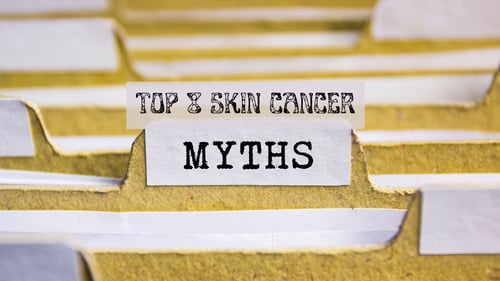Top 8 skin cancer myths you may still believe
Australia is the skin cancer capital of the world. We have more cases per capita than any other country, with over 800,000 non-melanoma skin cancers diagnosed every year and one Australian diagnosed with melanoma every 30 minutes.
With numbers like these, it’s important that we take skin cancer seriously. Unfortunately, there are a few myths and misconceptions to debunk first. Let’s discern fact from fiction so we can be better informed about our skin health and cancer risk.

MYTH: Skin cancer isn’t deadly.
FACT: Every five hours, one Australian dies from skin cancer.
Most skin cancer deaths are from melanoma, one of the deadliest forms of skin cancer. Skin cancer is largely curable if found and treated early enough, but if left undetected for weeks or months, it can spread into other parts of the body and become lethal.
MYTH: Skin cancer only affects older Australians.
FACT: Melanoma is the most common cancer in young Australians aged 15-39.
Skin cancer can occur in anyone of any age. While people aged over 55 are at highest risk of skin cancer (mostly due to a lifetime of sun exposure), the disease is widespread among all age groups. As a result, all Australian adults should get a regular full-body skin cancer check.
MYTH: Only people spending lots of time outside need to worry about skin cancer.
FACT: 10 minutes in the sun can cause permanent cell damage and skin cancer.
You don’t need to get sunburnt for skin cancer to develop. Everyday exposure to the sun’s ultraviolet (UV) rays is enough to cause damage to your skin cells, leading to early signs of ageing and skin cancer. Just 10 minutes of unprotected sun exposure is enough to cause this damage – driving your car, walking your dog, hanging out the washing, gardening, or simply walking to the bus stop.
Did you know? Not all skin cancers develop after exposure to the sun. Some skin cancers are caused by hereditary factors or have an unknown cause.
MYTH: I tan rather than burn, so I won’t get skin cancer.
FACT: Tanning is the first sign of skin trauma, which leads to skin cancer.
There is no such thing as a healthy tan. Tanning is your skin’s reaction to trauma from the sun's UV rays; the pigment in your skin (melanin) darkens in an attempt to protect itself from further damage. Any time your skin tans or burns, your risk of skin cancer increases.
MYTH: People of colour don’t need to worry about skin cancer.
FACT: Anyone can get skin cancer, regardless of skin colour.
Did you know that Bob Marley died from a melanoma under his toe? While dark-skinned people are at lower risk of skin cancer due to the protective nature of their darker skin, they are not immune to developing the disease. In fact, people with dark skin are less likely to monitor their own skin and get regular skin checks, so skin cancers are often found later when chances of successful treatment are poor.
MYTH: Tanning beds are a healthy alternative for boosting vitamin D.
FACT: Using a tanning bed once increases your risk of skin cancer up to 67 per cent.
Commercial tanning beds are illegal in Australia, but unfortunately some private solariums still exist. Using a tanning bed just once increases your risk of melanoma by 20 per cent, squamous cell carcinoma by 67 per cent, and basal cell carcinoma by 29 per cent. This is because tanning beds use UV radiation – the same radiation emitted by the sun.
MYTH: I don’t need to worry about skin cancer in winter.
FACT: The Australian sun causes skin cancer all year.
In Australia, UV levels tend to be high all year. UV rays can’t be seen or felt (they are different from the sun’s light or heat) so the only way to know the UV levels is to check a daily UV forecast before you head outside, usually available wherever you attain weather predictions. A UV level above 3 requires you to protect yourself with sunscreen, a hat, sunglasses, long sleeves and pants. UV levels can remain high all year, even in cold climates and on cool or cloudy days. This means your skin cancer risk is lower in winter, but still present.
Read another blog on skin cancer risks in winter.
MYTH: My doctor can just remove my moles before they turn cancerous.
FACT: Skin cancer can develop very fast, sometimes within weeks or months.
It is dangerous to assume that your doctor can simply remove any suspicious-looking moles or freckles before they become cancerous. Skin cancer rarely develops in a pre-existing mole you've had your whole life. Further, a doctor usually removes a lesion once it develops cancerous symptoms, not before. Skin cancer can also develop very quickly, and without regular skin cancer checks, you might be at risk without knowing.
You should monitor your own skin for new or changing spots, but the signs of skin cancer aren’t always obvious. See a professional for a full-body skin cancer check at least once a year.
- Tags:
- Risks
- Skin Cancer
